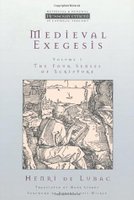Argument: Medieval exegesis isn’t simply allegory, for it goes far beyond the method of ancient pagan sources. Rather, it seeks the “spirit” of Scripture.
Medieval Exegesis. Volume 1: The Four Senses of Scripture. By Henri de Lubac. Translated by Mark Sebanc. Foreword by Robert L. Wilken. Ressourcement: Retrieval and Renewal in Catholic Thought. Grand Rapids, MI: Eerdmans
Henri de Lubac is a master writer and theologian, but this book presents a challenge to the reader on a number of levels. De Lubac opens the door to a wide forest of patristic and medieval thinking–and he provides no map to navigate this forest. (Later volumes in the series do provide the map). That’s not to say de Lubac fails to offer a model for medieval exegesis. He does. You just have to read for a while to find it. In what follows I will try to provide a model of medieval exegesis–or rather, foundational presuppositions.
P1: The letter teaches what happened, allegory what we should believe, moral what we should do, anagogical what we should hope for.
(P2) “For the doctrine of the two senses of Scripture and the doctrine of the relationship between the two testaments are in essence one and the same thing” (De Lubac 8).
In order to show that the “spiritual sense” of Scripture is not completely arbitrary, de Lubac notes that it is always tied to “discipline,” which implies a rule or manner (23ff). Scripture is sacrament and symbol, spirit and rationality (76). The implication is the letter of Scripture always points beyond itself. Scripture, like the world, is like a garment of the godhead.
Early Christian symbolism was liturgical symbolism. De Lubac writes, “It is well know that medieval symbolism readily encompasses not only Scripture and the visible universe, but that other universe, that other living, sacred book which is divine worship. The fathers transposed the ancient doctrine that saw the universe at once as a temple and as a body and each temple as being at once the human body and the universe. By virtue of this transposition, the cosmic and liturgical mirrors, while corresponding with each other, also correspond to the mirrors of history and the Bible” (103).
The Cross as Cosmic Universe:
“This Christian, who undertakes a new kind of De natura rerum, has achieved a profound realization of the cosmic dimensions of his faith. He wants to show forth a universe that has been entirely taken up by Christ and recreated in the same Christ…He plants the Cross of Christ at the center of everything, just as Virgil placed Orpheus in the middle of the cosmic cup. Time and Space, Heaven and Earth, angels and men, the Old Testament and the New, the physical universe and the moral universe, nature and grace: everything is encompassed, bound together, formed, “structured,” and unified by this Cross, even as everything is dominated by it” (111).
But there is a problem in the sources. Most of us are familiar with the so-called “fourfold method” (history, allegory, tropology, anagogy). But medieval and patristic writers didn’t always follow this model. Sometimes it was threefold, or maybe the terms were inverted. Is there a threefold distinction of Scripture, or a fourfold one? Sometimes authors collapsed anagogia into allegory.
Beginning with the fathers we note:
Body = history
Soul = tropology
Spirit = anagogy
The problem before the house: tropology was seen as an intermediary principle between body and spirit (140). There was a danger of introducing the “psuche” Scripture before its “pneuma.” This fails to respond to the intentions of the spirit. De Lubac highlights the problem: there “cannot be found in it an explicit allusion to the Mystery that is at once historical and spiritual, interior and social, a Mystery which is recapitulated in the other formula by “allegoria” (140-141). So which method is correct and when did the fourfold start? De Lubac doesn’t really tell us.
Unity and Harmony
Thesis: Christian tradition understands that Scripture has two meanings: literal and spiritual (pneumatic) and these two meanings have the same relationship to each other as do the Old and New Testaments to each other (225). The spiritual meaning discerns internal causes. The spirit is contained and hidden in the letter. History as a key to understanding the present is more and more transformed into allegory of the future (230).
Typology is not enough. It needs allegory, allegory understood as the pneumatic sense (259). Typology simply tells that A prefigures A’. It says nothing of the opposition or unity between the two testaments.
Conclusion and evaluation.
“High hopes and empty pockets” may be the best way to summarize this book. This is one of those instances where de Lubac’s brilliant reputation actually worked to his disadvantage. Given the rich spirituality of the patristics and medievals and de Lubac’s own brilliant handling of Augustinian Supernaturalism, one rightly expected this book to be a stunning tour de force. It wasn’t.
Given what I’ve read of de Lubac on the social dimension of Christianity and his take on the Surnaturel, I expected this book to outline the failure of liberal and fundmentalist hermeneutics (including, obviously, the failure of modernity), a brief section outlining the medievals’ take on Scripture, the structure of allegory, and how to do allegory in today’s church.
As tedious as this book was at times, it is a necessary read if one is interested in reading de Lubac’s corpus. Fortunately, volume two appears to be more smooth, compact, and focused on the main issues. It was that de Lubac seemed to merely compile quotations of people who agree with him. While I suppose that makes his point, he is always bordering on overkill (I tried to pull this stunt on graduate level essays. The profs were not amused!). Still, at the end of the day when reading de Lubac, one knows one is in the presence of a master.
